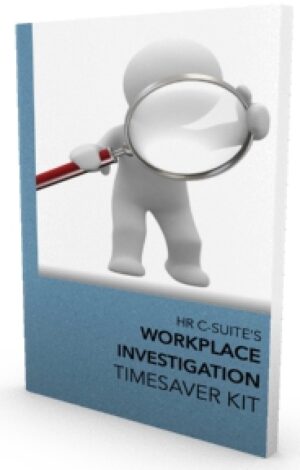You’ve just been informed of an employee complaint of workplace harassment by a co-worker, and you’re
changing your calendar to make time to conduct an investigation. You let your manager know about the complaint and when you’ll begin the investigation. You quickly review the company policy on harassment and wish again today that you had a template set up to document the discussions you’ll be conducting. You pull out the documentation from the last investigation to use as a guide. You re-promise yourself you’ll do research and create a template and a procedure.
Have you ever experienced a similar situation? It happened to me, in fact, on my first day at a new job!
I’ve held responsibility for Employee Relations and for Compliance in several roles over the years. Most Human Resources professionals are well aware of the obligation companies have to conduct timely fact-finding investigations of alleged conflicts and of complaints about behavior that violates company policy such as harassment, discrimination, retaliation, safety and ethics. This includes both taking immediate steps to stop such behavior and taking corrective actions that are determined as a result of the completed investigation.
The purpose of this article is to help you as an HR Professional to create the tools and processes you need to manage workplace investigations promptly and to make it easy to take actions that are effective, fair and compliant in resolving the issues -- as well as preventing and minimizing disruption of the work environment.
Through research, training and experience we have identified what we believe are the 10 key components of an effective workplace investigation. This article is intended to serve as a resource for HR professionals to develop your own Investigation processes, procedures, and templates. We recommend that you customize your investigation process and tools to fit your organization, and that you obtain legal review and advice, as laws are different based on locality and change over time.
1. Set the stage.
- Inform your manager, the complainant’s manager and the accused’s manager of the situation and the investigation process. Ask them to keep your conversation confidential and to refrain from taking action or communicating about it other than informing their managers if appropriate.
- Select discreet meeting locations for the investigation interviews.
- Provide water and tissues in each interview location.
 2. Review these ground-rules.
2. Review these ground-rules.
- Be empathetic but objective. Do not take sides or judge.
- Explain that the matter will be kept as confidential as possible, with some details shared with certain management members in order to complete the investigation. Find out who the complainant has told (i.e. co-workers, leads, supervisors, managers). Obtain commitment to maintain confidentiality, to refrain from discussing the issue with co-workers.
- Focus the investigation on what happened, not on making a legal determination. Remember that the purpose of the investigation is to surface facts that will help determine whether or not a company policy has been violated.
- Ask enough good questions to obtain the information you need. Use open-ended questions and don’t ask leading questions. Follow up with clarifying questions to get all of the facts and details of the situation.
- Open-ended: What happened? Or: I understand a situation developed in your work area in your presence at 5:00 p.m. yesterday. What can you tell me about it?
- Leading: I understand Jason behaved inappropriately with Mary in the work area yesterday in your presence at about 5:00 p.m.. Tell me what you know.
- Ask if there are witnesses who may have observed or overheard the event, and find out who the interviewee has made aware of the issue. For example, has he/she brought this matter to anyone else at work such as a co-worker, supervisor, lead, or manager?
- Ask the interviewee to tell you what he/she believes should happen as a result of bringing the issue to you (management) -- What outcome or actions would satisfactorily resolve the matter for him/her?
3. Complete the documentation during your interview meeting.
- Provide time before the interviewee leaves your office, to write his/her statement, sign and date it. Don’t allow the individual to leave your meeting before doing this.
- Provide a comfortable atmosphere in your presence; for example, while the interviewee writes his/her statement, you might be working at your computer.
- Note: if the statement is being given to HR by telephone, read the notes back to confirm accuracy and note that on the form in the signature section, which would have only HR’s signature on record until you’re able to use overnight mail to obtain a signed original.
- To protect confidentiality of these documents it is best not to email them for signature and electronic return.
4. Provide interim protection if appropriate.
- Depending on the situation, you may determine that immediate action should be taken to protect the complainant. For example, separate the complainant and the accused using an interim transfer or investigatory leave, to prevent further exposure to the behavior at issue or from possible retaliation that could occur during the investigation.
- It is important to keep in mind that complaining employees should not be involuntarily transferred or burdened; agree with the complainant on appropriate measures. Obtain legal advice if appropriate prior to making any decisions.
5. After accepting the complainant’s Statement, contact and arrange to meet promptly with the accused.
It is important to meet with the accused next, as his/her input may generate questions you may want to ask of witnesses. In addition, acting promptly helps ensure the accused is/are interviewed before any possible breach of confidentiality can forewarn him/her/them.
- Do not inform the employees of the specific reason for the meeting until you are in your meetings with them. For example, you could let them know you’d like to meet with them to obtain some confidential information that you need.
 6. Prepare the Investigation Plan.
6. Prepare the Investigation Plan.
- List witnesses identified by the complainant and the accused. These are the only additional interviews needed for the investigation. We recommend you minimize disruption of the workplace by restricting the involvement of other employees to include only those who likely observed and/or overheard the event. If new witnesses are identified during the investigation process add them to the interview list.
- Determine whether you or someone else is the appropriate investigator for the particular issue. The appropriate investigator should meet the following criteria:
- Be able to be objective; not be influenced by prior knowledge of anyone involved; ability to be neutral, not choose sides.
- Not have a personal relationship with any of those involved.
- Not be impacted professionally by the outcome.
- Have patience, a calm, neutral demeanor, skills to build a rapport, be perceived as fair, able to obtain sufficient details through effective interviews, and hold a position in the company to maintain confidentiality and provide timely resolution.
- Determine whether you will conduct investigation interviews 1x1 or whether you’ll have a neutral observer present (for example, the employee’s supervisor/manager or another HR professional).
- Decide which approach will enable the Interviewee to be most comfortable being forthright.
- Having a neutral observer present can be helpful in preventing concerns of bias.
- If a violent response is viewed as possible, having a Security professional based discreetly nearby will be essential.
- Identify any additional resources for information and/or evidence such as video surveillance, electronic security/access data; employee personnel files; records of prior Investigations that may be applicable (for example, to review consistency in corrective actions)
- Review and select templates that will be utilized. You may have Investigation Confidentiality Agreements signed by those interviewed as part of the investigation, Investigation Close-out Memo’s for complainants and accused are typical. Investigation Confidentiality agreements, if used for one should be used for all interviewees involved in the investigation. Or, if you decide oral commitments to maintain confidentiality are more appropriate, then each individual interviewed should be asked to make that oral commitment.
7. Interview each person individually, not in pairs or groups.
- Allow time between each interview meeting to type up your notes.
- Remember to obtain written statements from each individual interviewed, and have them signed during your interview meetings.
8. Decide.
- Analyze statements, your notes, and the other factual information available. Identify and conduct any follow-up interviews that need to be conducted to ask any new questions you’ve developed. Determine what you believe happened, evaluate company policies and past practices, discuss your findings and recommendations with your legal counsel and your manager and come to agreement on next steps.
- Generally, an investigation could close out in three ways:
- Finding in favor of the complainant
- No finding (the complaint was not corroborated by others interviewed or other information sources)
- Finding in favor of the accused (the investigation produced evidence that the complaint was unfounded or malicious)
- Meet with approving manager(s) as needed to make the final determination, decide on corrective actions if any, determine management actions to prevent retaliation if applicable, and management’s monitoring plan (with means of documentation) to ensure the issue is fully resolved.
- Develop close-out memos for the complainant and the accused.
9. Close out the investigation.
- Conduct separate close-out meetings with the complainant and the accused, including each employee’s manager if appropriate.
- Provide both the complainant and the accused with a close-out memo and a copy of the policy, if any, relevant to the behavior at issue for the investigation.
- Do not inform the complainant of the specific corrective action being taken with the accused; inform the complainant that management has taken the issue seriously and has taken effective action. Inform the complainant and the accused of monitoring, follow-up and other actions planned to support effective closure of the matter. For example, if follow-up interviews have been decided upon, they should be informed and the first follow-up meeting should be scheduled.
- Handle questions, thank them and express your confidence that the matter has been permanently resolved. Again remind them of the obligation each has to maintain confidentiality.
10. Follow Up
- Document the closure decisions and the approval obtained, the results of the close-out meetings, and organize all documentation for filing in an appropriate, secure, confidential location (not in the employee personnel files).
- Complete, document and file monitoring plans put in place and the results of those plans.
Get these FREE editable templates by clicking on the image below!
- Template: Statement By Reporting Participant
- Template: Investigation Confidentiality Agreement
- Template: Statement by Witness
- Template: Investigatory Leave Notice
- Template: Investigation Close-Out Letter to Reporting Employee


Please send me these templates:
•Template: Statement By Reporting Participant
•Template: Investigation Confidentiality Agreement
•Template: Statement by Witness
•Template: Investigatory Leave Notice
•Template: Investigation Close-Out Letting to Reporting Employee
THANK YOU
This is a very useful resource! I really like how HRCSuite emphasizes structured, consistent processes for workplace investigations. Having a centralized system to manage evidence, maintain confidentiality, and follow clear workflows makes the process more efficient, transparent, and fair. It’s a great reminder that using the right tools not only improves compliance but also builds trust within an organization. Thanks for sharing!
Hi, Wes,
I am delighted that you’re finding this toolkit useful. I appreciate your taking the time to share your thoughts and experience using it.
All the best,
Rosanna Nadeau